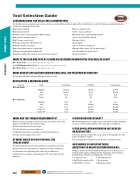Page 530 - CAT4
P. 530
Tool Selection Guide
CONSIDERATIONS FOR SELECTING SCREWDRIVERS
This should be done in a systematic way to ensure no details are overlooked that could have an adverse affect on job function or results. The following are variables that must be considered to ensure proper tool selection.
What is being assembled?
What material is involved?
What type of screw or nut is being driven? What head type?
What screw size (standard or metric)?
What U.S. grade or metric class?
What torque (inch pounds or Newton meters)?
What torque tolerance (accuracy)?
What is the run-down torque vs. seating torque?
What type of joint pull-up (hard, medium, soft)?
What pull-up conditions (free run-down, sheet metal, wood, or plastic)?
What is the production rate?
Are there clearance problems?
What handle style is required (straight or pistol)?
Is the tool to be hand held or fixtured?
What type of clutch?
Speed required?
Is there a need for a reversible tool?
What type of drive (square, 1/4" hex, quick change)? How is the application being done now?
Special consideration?
WHAT IS THE SIZE AND TYPE OF SCREW OR FASTENER ON WHICH THE TOOL WILL BE USED?
No 1 Series Tools – 2 to 50 in lb of torque. (Fasteners up to 1/4")
.6 & 1 HP Signature Series Tools – 5 to 400 in lbs of torque. (Fasteners up to 3/8") No 3 Series Tools – 5 to 50 ft lbs of torque. (Fasteners up to 1/2")
WHAT KIND OF APPLICATION AND MATERIAL WILL THE FASTENER BE USED ON?
The type of material helps to determine which type of clutch is needed.
APPLICATION & MATERIAL GUIDE
Screw Size
No 8 and Smaller
No 10 and Larger
Clutch
Adjustable Stall Direct Positive
Adjustable Stall Direct Positive “P” Positive “PS”
Free Run Down
Excellent Excellent Good Fair
Good Good Good Good Good
Soft Pull-Up
Excellent Good Good Fair
Fair Excellent Excellent Excellent Excellent
IS REVERSING NECESSARY?
Prevailing Torque
Excellent Excellent Good Good
Fair Excellent Excellent Excellent Excellent
WHAT ARE THE TORQUE REQUIREMENTS?
Most air tools share the quality: as the speed increases, the torque decreases. This applies to tools within the same horsepower rating.
A. Stall or direct clutch gives the most torque.
B. Positive clutch tools are operator influenced.
C. Adjustable torque clutches are available on most Sioux fastening tools. D. Torque control is available on No 1 series
AT WHAT ANGLE OR POSITION WILL THE
TOOL BE USED?
This will determine the style of tool best suited from an ergonomics point of view.
A. If the fastener is in a vertical position, a straight or lever style tool will be best.
B. If the fastener is in a horizontal position a pistol style tool will be best.
C. If the fastener is in a tight or constricted area the “2S” series works well in this application.
Most fastening applications are going to require a reversible tool. Keep in mind that in most cases a non-reversing tool will have more torque than a reversible tool.
IS THE APPLICATION OPERATOR INFLUENCED
OR RESTRICTED?
A. Is the operator male or female? This can be a factor in determining the size of the power tool (weight for example).
B. Does the application lend itself to an auto start tool, as in the No 1 series?
AN EXAMPLE OF APPLYING THESE
QUESTIONS TO AN APPLICATION WOULD BE:
Driving a 2" long wood screw into hardwood with a pilot hole. The fastener is in a horizontal position during assembly. A test with a hand torque wrench indicates a prevailing torque of 80 in lbs, and a failing torque of 120 in lbs.
1. 2" long wood screw
2. Hard Wood use positive clutch 3. SSD10P20PS – 100 in lbs
4. Pistol will work best 5. Need reversing
6. Mostly male workers
530
SafetyPrecaution: Readandfollowallsafetyandoperationinstructions.
Warning: Face & eye protection must be worn while operating power tools, per ANSI B186.1.
ASSEMBLY POWER TOOLS


